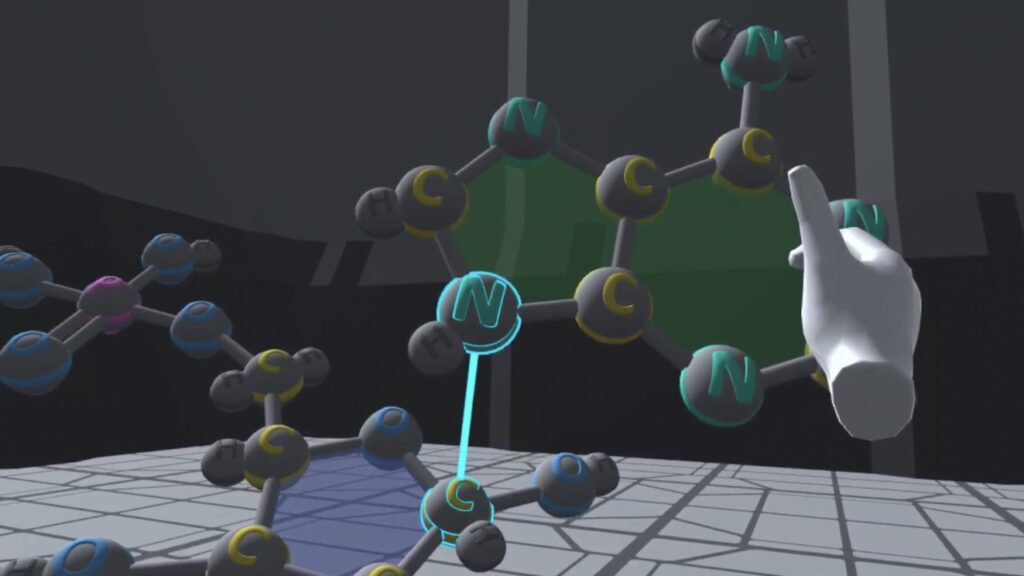

Virtual Reality (VR) has emerged as a game-changing tool in STEM education, offering immersive experiences that transform abstract concepts into tangible realities. While many associate VR chemistry with simulating dangerous or expensive experiments, its potential extends far beyond safety measures. One of the most exciting applications is in helping students visualize and manipulate complex molecular structures, particularly DNA.
Traditional methods of teaching DNA structure often rely on static images or physical models. However, these approaches can fall short in conveying the dynamic nature of molecular interactions. Virtual reality in education bridges this gap by offering an interactive, three-dimensional experience that brings DNA to life. Through VR education apps, students can explore the intricate details of DNA, enhancing their understanding and retention.
At XReady Lab, we introduce the Nucleotide Factory, an innovative VR education software that redefines how students learn about DNA structure. This immersive VR experience allows students to step into the role of cellular engineers, where they can create DNA nucleotides from scratch. By interacting with detailed 3D models of deoxyribose, phosphate groups, and nitrogenous bases, learners engage in hands-on activities that illustrate the complex chemical bonds and molecular interactions that make up DNA. This practical approach transforms a traditionally challenging topic into an engaging and interactive learning experience.

The Nucleotide Factory is tailored for high school biology and advanced chemistry courses, providing a comprehensive understanding of biochemical macromolecules. Instead of passively memorizing formulas, students explore and manipulate DNA structures in a dynamic virtual environment. The simulation’s adaptive difficulty ensures it meets various educational standards and grade levels, making it a versatile tool for a wide range of students. This VR experience not only enhances spatial awareness of DNA’s double-helix structure but also fosters a deeper appreciation for molecular biology through immersive, hands-on learning.
Incorporating VR into your science lesson plans offers numerous advantages:
As VR technology in education continues to evolve, we can expect even more sophisticated simulations covering advanced topics like gene expression, protein synthesis, and genetic engineering. The possibilities are endless, and the future of biology education looks brighter than ever.
Discover how XReady Lab’s Nucleotide Factory can transform your biology or chemistry lessons. Our innovative VR education services are designed to make complex scientific concepts both accessible and engaging. Visit our demo request page to experience our cutting-edge VR apps and see firsthand how they can elevate your classroom experience.
Don’t just teach DNA structure — let your students experience it in a dynamic virtual environment. With XReady Lab’s VR simulations, you’re not merely instructing; you’re igniting curiosity and inspiring the next generation of scientists and innovators.
As we continue to push the boundaries of educational technology, VR stands out as a transformative tool for teaching complex scientific concepts. By incorporating VR into your curriculum, you’re not just teaching biology – you’re providing an unforgettable journey into the molecular world that will inspire the next generation of scientists.
Frequently Asked
We prodive VR biology, VR physics, and VR chemistry simulations. Please, check our catalog.
Please, fill the form to get demo labs for free.
Please contact our customer support service at support@xreadylab.com or book a call with the team to find out the conditions and book the VR class set up at your school.
Subscription to XReady Lab interactive VR labs. If you are a school, then you are also given access to the VR classroom system. VR class system helps you easily launch VR lessons for a large number of students, follow the experience of each student, as well as customise the content without developers.
We adhere to the world’s generally accepted recommendations and research. Our products are suitable for children from 12 years old.